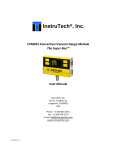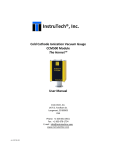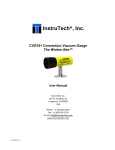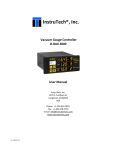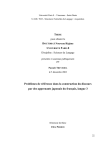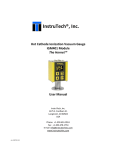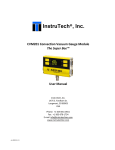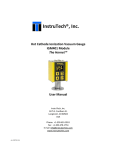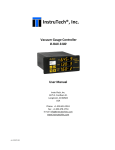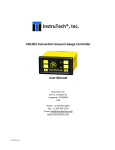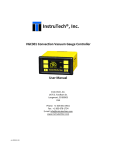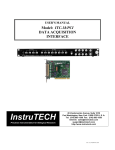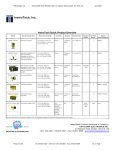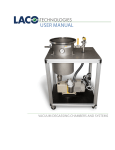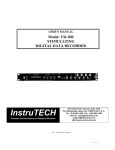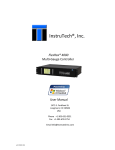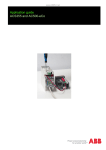Download CCM501 User Manual - InstruTech®, Inc.
Transcript
InstruTech®, Inc. Cold Cathode Ionization Vacuum Gauge CCM501 Module The Hornet™ User Manual InstruTech, Inc. 1475 S. Fordham St. Longmont, CO 80503 USA Phone: +1-303-651-0551 Fax: +1-303-678-1754 E-mail [email protected] www.instrutechinc.com p/n 001587-104 Instruction Manual Important User Information CCM501 Hornet There are operational characteristic differences between solid state equipment and electromechanical equipment. Because of these differences, and because there are a variety of uses for solid state equipment, all persons that apply this equipment must take every precaution and satisfy themselves that the intended application of this equipment is safe and used in an acceptable manner. In no event will InstruTech, Inc. be responsible or liable for indirect or consequential damages that result from the use or application of this equipment. Any examples or diagrams included in this manual are provided solely for illustrative purposes. Because of the many variables and requirements imposed on any particular installation, InstruTech, Inc. cannot assume responsibility or liability for any actual use based on the examples and diagrams. No patent liability is assumed by InstruTech, Inc. with respect to use of information circuits, equipment, or software described in this manual. Throughout this manual we use notes, notices and apply internationally recognized symbols and safety messages to make you aware of safety considerations. Identifies information about practices or circumstances that can cause electrical or physical hazards which, if precautions are not taken, could result in death or serious injury, property damage, or economic loss. CAUTION CccWARNING Identifies information about practices or circumstances that can cause electrical or physical hazards which, if precautions are not taken, could result in minor or moderate injury, property damage, or economic loss. WARNING NOTICE Identifies information that is critical for successful application and understanding of the product. SHOCK HAZARD CccWARNING Labels may be located on or inside the device to alert people that dangerous voltages may be present. WARNING InstruTech, Inc. Page 1 Copyright © 2011 by InstruTech, Inc. All rights reserved. No part of this work may be reproduced or transmitted in any form or by any means, electronic or mechanical, including photocopying and recording, or by any information storage or retrieval system, except as may be expressly permitted in writing by InstruTech, Inc. Printed in the United States of America Conflat® is a registered trademark of Varian, Inc. / Agilent Technologies, Lexington, MA p/n 001587-104 Instruction Manual CCM501 Hornet Table of Contents 1 2 3 Introduction / General Information ......................................................................................................3 1.1 Description ....................................................................................................................................3 1.2 Specifications ................................................................................................................................3 1.3 Dimensions ....................................................................................................................................4 1.4 Part Numbers ................................................................................................................................4 1.5 Options & Accessories...................................................................................................................4 Important Safety Information ...............................................................................................................5 2.1 Safety Precautions - General.........................................................................................................5 2.2 Safety Precautions - Service and operation ..................................................................................6 2.3 Electrical Conditions......................................................................................................................7 2.3.1 Proper Equipment Grounding ...............................................................................................7 2.3.2 Electrical Interface and Control .............................................................................................7 2.4 Overpressure and use with hazardous gases ...............................................................................7 2.5 Gases other than Nitrogen / air ....................................................................................................8 Installation ............................................................................................................................................9 3.1 Mechanical Installation .................................................................................................................9 3.2 Electrical Installation ...................................................................................................................10 3.2.1 Grounding ............................................................................................................................10 3.2.2 Connectors ...........................................................................................................................10 3.2.3 Connectors pin-out ..............................................................................................................11 4 Bakeout ...............................................................................................................................................12 5 Setup and Operation ...........................................................................................................................13 5.1 Applying power ...........................................................................................................................13 5.2 Overpressure shut down.............................................................................................................13 5.3 User Interface Basics ...................................................................................................................13 5.4 Factory-Set Default Parameters..................................................................................................14 InstruTech, Inc. Page 1 Instruction Manual 5.5 CCM501 Hornet Programming...............................................................................................................................15 5.5.1 SETUP DISP ...........................................................................................................................15 5.5.2 SETUP UNIT ..........................................................................................................................16 5.5.3 SETUP IG...............................................................................................................................17 5.5.4 SETUP COMMS.....................................................................................................................19 5.5.5 SERVICE MENU.....................................................................................................................19 5.6 Activating the sensor ..................................................................................................................20 6 Using the gauge with different gases .................................................................................................21 7 Analog Output .....................................................................................................................................22 7.1 0 to 8 Vdc, 1 V/decade analog output ........................................................................................22 7.2 8 7.2.1 1.8 to 8.7 Vdc, 0.8 V/decade analog output - Torr ..............................................................23 7.2.2 1.8 to 8.7 Vdc, 0.8 V/decade analog output - mbar ............................................................24 7.2.3 1.8 to 8.7 Vdc, 0.8 V/decade analog output - pascals .........................................................25 RS485 serial communications .............................................................................................................26 8.1 Device Specific Serial Communication Info.................................................................................26 8.2 9 1.8 to 8.7 Vdc, 0.8 V/decade analog output ...............................................................................23 RS485 Command Protocol Summary ..........................................................................................27 Service .................................................................................................................................................28 9.1 Calibration ...................................................................................................................................28 9.2 Maintenance ...............................................................................................................................28 9.3 Troubleshooting - Error Messages ..............................................................................................28 9.4 Troubleshooting - Operation ......................................................................................................29 9.5 Contamination ............................................................................................................................30 9.6 Cold Cathode Sensor Replacement.............................................................................................31 9.7 Cold Cathode Sensor Cleaning ....................................................................................................32 10 Factory Service and Support ...............................................................................................................33 11 Warranty .............................................................................................................................................33 InstruTech, Inc. Page 2 Instruction Manual CCM501 Hornet 1 Introduction / General Information 1.1 Description A cold cathode ionization gauge measures vacuum pressure by first ionizing gas molecules inside the vacuum gauge and then measuring the resulting ion current. A large potential between the sensor anode and cathode will cause ionization to occur. The amount of ion current generated from the ionized gas is proportional to the pressure in the vacuum system and is dependent on the type of gas used. As the pressure inside the vacuum system drops, the measured ion current drops. The design of InstruTech’s cold cathode transducer includes an internal O-ring which will allow easy disassembly for cleaning. The InstruTech® CCM501 Hornet™ module provides the basic signal conditioning required to turn a cold cathode vacuum gauge into a complete measuring instrument. The module provides a log-linear analog output, RS485 serial communications, and one setpoint relay. In addition, a built-in display provides a convenient user interface for setup and operation of the vacuum gauge. The measurement range for the CCM501 cold cathode ionization gauge is 1 x 10-9 to 1 x 10-2 Torr. 1.2 Specifications measurement range accuracy - N2 (typical) operating storage input signal -2 -8 -2 -9 -2 mbar / 1.3 x 10 -7 Pa to 1.3 Pa 1 x 10 to 1 x 10 Torr; ± 30% of reading ± 5% of reading OLED graphical display, 2 digits plus 1 digit exponent, user-selectable Torr, mbar, or Pa 304 stainless steel, ceramic, Viton® O-ring -1 10 Torr (also user adjustable between 1 to 99) -2 gauge turns off at factory default setting of 1 x 10 Torr 3 3 1.965 in (32.2 cm ) o o 0 C to + 40 C o -40 to +70 C o 150 C (sensor only - electronics removed), Limit to 5 hours with magnets installed 0 to 95% relative humidity, non-condensing 1.7 lb. (0.77 kg) with NW25 KF flange aluminum extrusion any repeatability (typical) display materials exposed to gases sensitivity overpressure protection internal gauge volume operating temperature storage temperature bakeout temperature humidity weight housing (electronics) mounting orientation altitude serial communications analog Output setpoint relay status outputs -9 1 x 10 to 1 x 10 Torr / 1.3 x 10 to 1.3 x 10 8,200 ft. (2,500 m) max. 41,000 ft. (12,500 m) max. RS485 - ASCII protocol; minimum command interval: 50 ms user selectable scaling; log-linear 0 to 8 Vdc, 1 V/decade or 1.8 to 8.67 V, 0.8 V/decade one single-pole, double-throw (SPDT), 1 A at 30 Vdc resistive, or ac non-inductive anode (sensor) on/off status is determined by display messages, via open collector transistor or RS485 serial communications sensor enable is set by continuity to ground using digital input, RS485 serial commands or manually using front panel programming soft-keys input power 20 to 28 Vdc, 7.2 W protected against power reversal and transient over-voltages connectors 9-pin D-sub male for analog and 15-pin D-sub male for RS485 EMC Directive 2004/108/EC, EN61326-1, EN55011 Low Voltage Directive 2006/95/EC, EN61010-1 RoHS compliant CE compliance environmental InstruTech, Inc. Page 3 Instruction Manual 1.3 CCM501 Hornet Dimensions fitting 1 in. Tube NW16KF NW25KF NW40KF 1.4 1 1/3 in. Mini-CF 2.11 in. (54 mm) 2 3/4 in. Conflat® 2.63 in. (67 mm) Part Numbers Cold Cathode Module CCM501TD CCM501BD CCM501CD CCM501DD CCM501ED CCM501FD CCM501 Fittings / Flanges 1 in. Tube (1 in. O.D. O-ring compression) NW16KF NW25KF NW40KF 1 1/3 in. Mini-CF/NW16CF Mini-Conflat® 2 3/4 in. CF / NW35CF Conflat® 1.5 dimension A 2.56 in. (65 mm) 2.63 in. (67 mm) 2.63 in. (67 mm) 2.82 in. (72 mm) Replacement Sensor CC5T CC5B CC5C CC5D CC5E CC5F Options & Accessories ‘ PS501-A Description: Power supply Compatibility: Powers the CCM501 Hornet™ vacuum gauge module Power Input: Power Plug: Output: 100 - 240 Vac North American 115 Vac plug 24 Vdc @ 750 mA (18 W) Connector: 9-pin D-sub female to mate with and power the CCM501 module 6 ft. (2 m) Cable length: Note: InstruTech, Inc. 9-pin D-sub connector backshell can be opened to enable connections to signals and relays Page 4 Instruction Manual CCM501 Hornet 2 Important Safety Information InstruTech has designed and tested this product to provide safe and reliable service, provided it is installed and operated within the strict safety guidelines provided in this manual. Please read and follow all warnings and instructions. WARNING WARNING To avoid serious injury or death, follow the safety information in this document. Failure to comply with these WARNING safety procedures could result in serious bodily harm, including death, and or property damage. Failure to comply with these warnings violates the safety standards of installation and intended use of this instrument. InstruTech, Inc. disclaims all liability for the customer’s failure to comply with these instructions. Although every attempt has been made to consider most possible installations, InstruTech cannot anticipate every contingency that arises from various installations, operation, or maintenance of the module. If you have any questions about the safe installation and use of this product, please contact InstruTech. This device meets FCC part 15 requirements for an unintentional radiator, class A. 2.1 Safety Precautions - General Hazardous voltages are present with this product during normal operation. The product should never be operated with the covers removed unless equivalent protection of the operator from accidental contact with hazardous internal voltages is provided. WARNING! There are no operator serviceable parts or adjustments inside the product enclosure; refer servicing to service trained personnel. Do not modify this product or substitute any parts without authorization of qualified InstruTech service trained personnel. Return the product to an InstruTech qualified service and repair center to ensure that all safety features are maintained. Do not use this product if unauthorized modifications have been made. WARNING! Source power must be removed from the product prior to performing any servicing. After servicing this product, ensure that all safety checks are made by a qualified service person. When replacement parts are required, ensure that the parts are specified by InstruTech, Inc. Substitutions of nonqualified parts may result in fire, electric shock or other hazards. Use of unauthorized parts or modifications made to this product will void the warranty. To reduce the risk of fire or electric shock, do not expose this product to rain or moisture. These products are not waterproof and careful attention must be paid to not spill any type of liquid onto these products. Do not use these products if they have been damaged. Immediately contact InstruTech, Inc. to arrange return of the product if it is damaged. InstruTech, Inc. Page 5 Instruction Manual CCM501 Hornet Due to the possibility of corrosion when used in certain environmental conditions, it is possible that the product’s safety could be compromised over time. It is important that the product be periodically inspected for sound electrical connections and equipment grounding. Do not use if the equipment grounding or electrical insulation has been compromised. Safety Precautions - Service and operation 2.2 Ensure the CCM501 is properly connected to earth ground. Do not turn on the anode voltage and try to activate the sensor when pressure exceeds 1.00 x 10-2 Torr. WARNING! The power supply used in the Cold Cathode Gauge Module (CCM501) is subject to high voltages which could cause severe injury or death. In order to prevent electric shock and bodily harm, the user should wait 1 minute after power is removed before touching the CCM501 power supply components. WARNING! When the anode voltage is turned on and the sensor activated, 3,900 Vdc is present at the power supply and other components. DO NOT operate the CCM501 with the CCM501 enclosure removed. Contact with exposed electrical circuits in the CCM501 could result in death or serious injury. Use an appropriate power source of 20 to 28 Vdc, 7.2 W minimum. Turn off power to the unit before attempting to service the module. Turn off power to the unit before detaching the electronics from the sensor for sensor replacement, sensor cleaning or bake-out purposes. Turn off power to the unit if a cable or plug is damaged or the product is not operating normally according to this instruction manual. Contact qualified InstruTech service personnel for any service or troubleshooting condition that may not be covered by this instruction manual. Do not use if the unit has been dropped or the enclosure has been damaged. Contact InstruTech for return authorization and instructions for returning the product to InstruTech for evaluation. The most common cause of all vacuum gauge failures is contamination of the sensor. Noisy, abnormally low, or erratic readings and total gauge failure are possible indications of gauge contamination. Contamination can generally be characterized as either: A) A physical or chemical reaction of process gases with the sensor element. If such is the case, the sensor material is most likely not compatible with your application and a different gauge may be required. B) An accumulation of material on the sensor element. In this case, sensor cleaning may resolve the issue. Refer to the section 9.7 titled “Cold Cathode Sensor Cleaning” for detailed cleaning procedure. InstruTech, Inc. Page 6 Instruction Manual 2.3 CCM501 Hornet Electrical Conditions WARNING! When high voltage is present in any vacuum system, a life threatening electrical shock hazard may exist unless all exposed electrical conductors are maintained at earth ground potential. This applies to all products that come in contact with the gas contained in vacuum chambers. An electrical discharge within a gaseous environment may couple dangerous high voltage directly to any ungrounded conductor of electricity. A person could be seriously injured or killed by coming in contact with an exposed, ungrounded electrical conductor at high voltage potential. This condition applies to all products that may come in contact with the gas inside the vacuum chamber (vacuum/pressure containment vessel). 2.3.1 Proper Equipment Grounding WARNING! Hazardous voltages that could seriously injure or cause death are present in many vacuum processes. Verify that the vacuum connection port on which the ion gauge is mounted is electrically grounded. Consult a qualified Electrician if you are in doubt about your equipment grounding. Proper grounding of your equipment is essential for safety as well as intended operation of the equipment. The vacuum gauge transducer and enclosure of any control module must be connected directly to a good quality equipment earthing conductor. Use a ground lug on the vacuum connection flange of the pressure measurement device if necessary. WARNING! In order to protect personnel from electric shock and bodily harm, shield all conductors which are subject to potential high voltage electrical discharges in or around the vacuum system. 2.3.2 Electrical Interface and Control It is the user’s responsibility to ensure that the electrical signals from this product and any connections made to external devices, for example, relays and solenoids, are used in a safe manner. Always double check the system set-up before using any signals to automate your process. Perform a hazardous operation analysis of your system design and ensure safeguards and personnel safety measures are taken to prevent injury and property damage. 2.4 Overpressure and use with hazardous gases WARNING! Install suitable protective devices that will limit the level of pressure inside your vacuum chamber to less than what the vacuum chamber system components are capable of withstanding. The InstruTech CCM501 gauge should not be used at pressures exceeding 7000 Torr absolute pressure. Failure to provide adequate overpressure protection may result in bodily injury and possible equipment damage due to forcible release of component parts or explosion of the pressurized vessel. In cases where an equipment failure could cause a hazardous condition, always implement fail-safe system operation. For example, use a pressure relief device in an automatic backfill operation where a malfunction could result in high internal pressures if the pressure relief device was not installed on the chamber. DO NOT exceed pressures above 135 psia (7000 Torr, 9 bars) inside the sensor. If your chamber, vacuum vessel or connecting pipe goes to higher pressures, you should install an isolation valve or pressure relief device to InstruTech, Inc. Page 7 Instruction Manual CCM501 Hornet protect the gauge tube from overpressure conditions. With some fittings, actual safe overpressure conditions may be lower; for example, a quick-connect, O-ring compression fitting may forcibly release the gauge tube from the vacuum chamber fitting with only a few psi over local uncorrected barometric (atmospheric) pressure. CAUTION! If the internal pressure of a vacuum gauge device is allowed to increase above local uncorrected barometric pressure (atmospheric pressure side), vacuum fittings may release and possible overpressure conditions may cause leaks that would allow the gas inside the gauge tube to release into the atmosphere of the surrounding environment. Toxic, pyrophoric and flammable gases are examples of hazardous gases that if allowed to leak out of the vacuum/pressure containment vessel into the atmospheric environment, could cause bodily injury and possible damage to equipment. Never expose the gauge tube internal volume to pressure above local atmospheric pressure when using hazardous gases. 2.5 Gases other than Nitrogen / air WARNING! Do not attempt to use with gases other than nitrogen (N2) or air without referring to correction factor data tables. InstruTech gauges and modules are calibrated for direct readout of nitrogen or air. Do not attempt to use with other gases such as argon (Ar) or carbon dioxide (CO2), unless you have programmed the device for the appropriate gas or use accurate conversion data for N2 to other gases. Refer to section 6 titled “Using the gauge with different gases” for a more complete discussion. InstruTech, Inc. Page 8 Instruction Manual CCM501 Hornet 3 Installation 3.1 Mechanical Installation Mount the CCM501 as close as possible to the pressure you want to measure. Long or restricted, small diameter tubing will create a pressure difference between your process chamber and the gauge. This may cause a delay in response to pressure changes. Mounting the CCM501 too close to a gas source inlet may also cause measurement and control instability. The CCM501 can be mounted in any orientation, however, if possible, mount the gauge with port down to help minimize the effect of any particles or condensation collecting in the gauge. Do not mount the CCM501 where it will be subjected to excessive vibration. Vibrations may cause unstable readings, measurement errors and possible mechanical stress to components in the CCM501. Shield the CCM501 near ion or electron sources such as an electron beam or in a sputtering system. For electrical safety purposes the housing of the gauge must be grounded to the vacuum chamber. When using KF flanges, metal clamps must be used to ensure proper grounding. Do not attempt to modify your flange in order to use non-metallic-type flange clamps. Fittings/Flanges - follow the fitting/flange manufacturer's recommendations for installation and use. Use all metal vacuum fittings with metal seals when operating pressures are expected to be below 1.00 x 10-7 Torr (1.33 x 10-7 mbar, 1.33 x 10-5 Pa). InstruTech, Inc. Page 9 Instruction Manual 3.2 3.2.1 CCM501 Hornet Electrical Installation Grounding Be sure the vacuum gauge and the rest of your vacuum system are properly grounded to protect personnel from shock and injury. Be aware that some vacuum fittings, especially those with O-rings when not used with metal clamps, may not produce a good electrical connection between the gauge and the chamber it is connected to. Use a ground lug on the vacuum connection flange of the pressure measurement device if necessary. 3.2.2 Connectors Good, recommended practice is to remove power from any cable prior to connecting or disconnecting it. The CCM501 is provided with two D-sub connectors used for I/O interface as shown below: 1. 9-pin D-sub (DE-9P) male for analog interface. 2. 15-pin D-sub (DA-15P) male for RS485 serial communications. CCM501 I/O Interface When using InstruTech’s power Supply PS501A, connect the power supply to the ANALOG connector. If using a power supply other than InstruTech’s PS501A, connect your power supply to either the RS485 or the ANALOG connector as shown on the next page. Do not connect power to both connectors. Fabricate a cable according to your interface requirements. For analog signals and digital input use the 9-pin D-Sub connector. For serial communications use the 15-pin D-Sub connector. Refer to the following page for detailed explanations of the connectors pin-out. InstruTech, Inc. Page 10 Instruction Manual CCM501 Hornet 3.2.3 Connectors pin-out 15 -pin D-sub (DA-15P) male RS485 connector PIN NUMBER PIN DESCRIPTION 1 RS485 DATA B (+) Input/output 2 Power ground (Also when using RS485 serial communications, connect this pin to ground pin of your RS485 converter) 3 RS485 DATA A (-) Input/output 4 Power input, 20 to 28 Vdc, 7.2 W. Protected against power reversal, transients, and over-voltages. 5 to 15 Not used (Do not connect) 9-pin D-sub (DE-9P) male ANALOG connector (used for analog output and digital I/O) PIN NUMBER 1 2 3 4 5 6 7 8 9 InstruTech, Inc. PIN DESCRIPTION Sensor enable (HV On/Off). The cold cathode sensor is activated by applying a continuous ground. This will activate the CCM501 sensor and will turn on the high voltage (HV) to the anode. The sensor is turned off by removing the ground. See section 5.6 for other methods of activating the sensor. Power ground & sensor enable ground Analog output (Log-Linear 1 to 8 Vdc, 1 V/decade or 1.8 to 8.6 Vdc, 0.8 V/decade) Power input, 20 to 28 Vdc, 7.2 W. Protected against power reversal, transients, and over-voltages. Relay NC - Normally closed Relay NO - Normally open Analog output ground (Do not use for sensor enable ground) Relay common Sensor status. This is an output signal to other external instruments to confirm the anode is on or off. Signal: Open collector transistor (grounded emitter) rated at 40 V max. VCE, 50 mA max. Transistor off = Gauge OFF, transistor on = Gauge ON. Page 11 Instruction Manual CCM501 Hornet 4 Bakeout If desired, a chamber bake may be performed for new systems or after routine maintenance. The sensor can be baked out to 150 oC but the bakeout duration should not exceed 5 hours to prevent damage to magnets. Ensure the temperature of the sensor tube and the vacuum fitting to the sensor is at the same or above the chamber temperature. The electronic module must be removed from the sensor if the bake-out temperature is to exceed 70 oC. To bake out the sensor perform the following procedure: 1. 2. 3. 4. Turn off power to the CCM501. Disconnect the cable from the CCM501. Use a 3/32 in. size Hex key to remove the #4-40 socket head cap screws (SHCS) as shown below. Detach the electronics from the sensor by sliding the metal electronics enclosure away from the sensor. Pull the electronics enclosure with a continuous straight line motion away from sensor. 5. Perform bake out with the electronics removed. The bakeout duration should not exceed 5 hours to prevent damage to magnets. 6. Prior to reattaching the electronics, make sure the arrow on the magnet assembly is aligned with engraved line on anode assembly. 7. Reattach the electronics enclosure. Reinstall the 4-40 SHCS (4 ea). Bakeout InstruTech, Inc. Page 12 Instruction Manual CCM501 Hornet 5 Setup and Operation 5.1 Applying power Connect power to the CCM501 using the designated pins 4 and 2 of either the 9-pin D-sub Analog or the 15-pin D-sub RS485 connector. Do not connect power to both connectors simultaneously. Alternatively, you can power the device by connecting InstruTech’s PS501-A power supply to the Analog connector of the CCM501. When you connect power, the display will show “UNIT STATUS OFF”. This indicates the display is on but the anode voltage is not turned on and the sensor has not been activated yet. Read this user manual in its entirety before activating the sensor. Refer to section 5.6 titled “Activating the sensor” for further details. 5.2 Overpressure shut down The CCM501 is provided with factory set default values for overpressure shut down. The gauge will shut off automatically should the pressure reach or rise above the pressure shut down values shown below: Factory set overpressure shut down values Overpressure Shut Overpressure Shut Overpressure Shut Down (Torr) Down (mbar) Down (Pa) 1.00 x 10-2 1.33 x 10-2 1.33 5.3 User Interface Basics The user interface is designed for easy operation and a natural progression of setup parameters. This section gives a brief explanation of operation for added clarity. There are four soft-keys located on the front panel, below the display. These keys are used to select and program the various functions available. During programming of the CCM501, the display will identify what each function key represents. To begin programming, press the MENU key. Press the ENTER key to access the parameters and save the new settings. Press the UP and DOWN key to select the desired menu and change the parameters. Press the MENU Key to return to the previous menu or press repeatedly to return to the main screen. To continue setting additional parameters, scroll with the UP and DOWN keys until you reach the desired parameter. InstruTech, Inc. Programming soft-keys Page 13 Instruction Manual 5.4 CCM501 Hornet Factory-Set Default Parameters The following is a summary of all factory-set default values in the CCM501 display menu. SETUP DISP - SET CONTRAST [Factory default = 10] - MODE [Factory default = NORMAL] - FLIP SCREEN [Factory default = NORMAL] SETUP UNIT - UNITS [Factory default = TORR] - DEFAULTS [Factory default = MENU TO EXIT] - GAS TYPE [Factory default = N2] - CLR IG ERROR [Factory default = OFF] - OVER PRESS [Factory default = 1.00E-02 TORR] - IG CNTL [Factory default = DIGI /RS485] SETUP IG - SENSITIVITY [Factory default = 10] - CAL FACTORS C [Factory default = C0, C1, C2, C3, C4, C5 actual sensor calibration factors factory-set] - HV TIMEOUT [Factory default = 10 min] - RLY I LO TRP [Factory default = 1.00E-06 TORR] - RLY I HI TRP [Factory default = 5.00E-06 TORR] - RELAY I TEST [Factory default = OFF] - ANALOG MODE [Factory default = 0 - 8 V LOG] SETUP COMMS - BAUD RATE [Factory default = 19200, 8, N, 1] - ADDR [Factory default = 1] - ADDR OFFSET [Factory default = 0] SERVICE MENU - INFO [Factory default = FIRMWARE VERSION] - OP TIME [Factory default = TOTAL TIME OPERATIONAL <hours> 0.0] InstruTech, Inc. Page 14 Instruction Manual 5.5 CCM501 Hornet Programming This section provides detailed information on programming and configuration of various menus and submenus of the device. 5.5.1 SETUP DISP - SET CONTRAST [Factory default = 10] This function sets the display contrast. Use the ENTER KEY to access the CONTRAST menu and use the UP and DOWN Keys to select a number between 1 and 255. The contrast setting of 255 provides the highest contrast (brightest) and 1 the lowest. Select the ENTER KEY again to save the value selected. Note- Factory default setting optimizes display life - MODE [Factory default = NORMAL] Use the ENTER KEY to access the MODE menu and use the UP and DOWN Keys to select the NORMAL or RESEARCH display mode. Select the ENTER KEY again to save the desired mode. Normal This mode displays the most commonly used parameters. These are the measured pressure, the pressure unit, the gas symbol and the relay status. All these variables will be displayed on the main screen simultaneously. In the following example, the measure pressure is 6.45E-8 Torr, gas is nitrogen and Relay I is on. Negative Exponent Indicates Pressure Unit Gas Symbol 6.4E 8 TORR N2 RLY I Measured Pressure Indicates Relay is On* * Note- The indication “RLY I” is not shown in the display when the relay is not energized (turned off). RESEARCH This mode displays the measured pressure, anode voltage and total current. In the following example, the measured pressure is 1.00E-8 Torr, pressure unit is based on selected units in SETUP UNIT menu. Anode voltage is 3.90E+3 Vdc and total current is 1.00E-7 amperes. Negative Exponent Anode Voltage (Vdc) Total current value (amperes) InstruTech, Inc. PT= 1.00E-8 HV= 3.90E+3 IC= 1.00E-7 Measured Pressure Page 15 Instruction Manual CCM501 Hornet - FLIP SCREEN [Factory default = NORMAL] This allows the user to select a NORMAL display or have the pressure measurement data displayed UPSIDE DOWN. When the CCM501 is mounted upside down, this selection is used to invert the display screen 180 degrees for user convenience. Note- When Upside Down is selected, the user has to save the setting and exit the menu before the measured values are displayed. 5.5.2 SETUP UNIT - UNITS [Factory default = TORR] Select from Torr, mbar or pascal. Units selected are used for all other settings. - DEFAULTS [Factory default =MENU TO EXIT] The module can be returned to the original factory settings by using the ENTER Key to set factory defaults. Note- You must re-enter the actual sensor CAL FACTORS C values marked on the sensor tube. - GAS TYPE [Factory default = N2] Use the UP and DOWN Keys to select from a table of 16 commonly used gases. Gas choices are: N2 , Air, O2 , CO, H2O, NO, Ar, CO2 , Kr, SF6 , Xe, Hg, He, Ne, D2 , and H2 . CAUTION! If you intend to use nitrogen as the default gas setting even though the gas in use is not nitrogen, you can select N2 from the menu, but you must manually apply a gas sensitivity correction factor to the displayed measurement and outputs. Refer to section 6 titled “Using the gauge with different gases”. - CLR IG ERROR [Factory default = OFF] When the CCM501 Ionization Gauge (IG) experiences an error condition such as OVERPRESSURE, HV FAILURE or CURRENT FAIL, the voltage to the CCM501’s anode will turn off and the module will stop measuring pressure. Error messages will be displayed on the CCM501 screen showing the error. This is intended to prompt the user to determine what the error condition is before the anode voltage can be turned on again. Once the cause of the error has been determined and resolved, the error must be cleared before the anode voltage can be turned on again. The CLR IG ERROR allows the user to clear the IG error using the front panel push buttons, regardless of whether the IG CNTL mode below is set to Front Panel, Digital Input or RS485. - OVER PRESS [Factory default =1.00E-02 TORR] This allows the user to set a pressure value at which the gauge anode voltage will automatically turn off. No value higher than 1.00E-02 TORR can be set. -IG CNTL [Factory default = DIGI/RS485] This allows the user to choose the source of control for the IG. The IG can be controlled via digital inputs, RS485 commands or front panel. DIGI/RS485: The DIGI/RS485 allows the application of a digital input or RS485 communication commands to operate the CCM501. The default state of the DIGI/RS485 selection is Digital input. This requires grounding pin 1 of the 9-pin D-sub ANALOG connector to turn on the anode voltage and activate the sensor. User should verify the DIGI/RS485 is selected in the IG CNTRL submenu of the SETUP UNIT menu. When InstruTech, Inc. Page 16 Instruction Manual CCM501 Hornet operating in the Digital Input (DIGI) mode, the anode voltage can be turned on only by applying continuity to ground to pin 1 of the 9-pin D-sub ANALOG connector. To change from Digital Input to RS485 communication mode, use the RS485 D-sub (RS485 15-pin D-sub connector). The user should verify DIGI/RS485 is selected in the IG CNTL submenu of the SETUP UNIT menu. In order to operate in the RS485 mode, the user must send an RS485 SET command which will cause the CCM501 to automatically switch to RS485 mode. For example, a SET command to turn the anode voltage on must be sent to the CCM501 in order for the gauge to auto switch to the RS485 mode. Sending READ commands such as read gauge pressure will not accomplish this task. When operating in the RS485 mode, all other inputs are ignored. Note - To change from the RS485 to another IG CNTL mode, the reset command must be sent to the CCM501 or power must be turned off and on. This will reset IG CNTL to DIGl/RS485 factory default setting with the default state of this selection being the Digital Input (DIGI) again. HV ON/OFF [Factory default = OFF] This allows the user to turn the anode voltage on and activate the sensor manually using the front panel soft-keys. This is achieved by selecting HV ON/OFF in the IG CNTL submenu of the SETUP UNIT menu. In this case the HV ON/OFF overrides any other input and the DIGI/RS485 inputs are ignored. The message “OFF” will appear if HV ON/OFF is selected indicating the anode voltage is off. Use the UP or DOWN arrow softkeys to select ON and ENTER to activate the sensor. Note- To change from HV ON/OFF control back to Digital (DIGI) control, turn off HV by selecting HV On/Off in the SETUP UNIT- IG CNTL menu; use the UP or DOWN arrow key to select OFF and press ENTER. Return to the IG CNTL menu and highlight DIGI/RS485 and press ENTER, then press ENTER again to select DIGI control. Press MENU several times to return to the main screen. 5.5.3 SETUP IG - SENSITIVITY [Factory default = 10] Factory pre-set sensitivity is always 10 and maybe adjusted by the user if necessary. Ion Gauge pressure readings are calibrated for nitrogen. If you use a different species of gas or mixture of gases other than the 16 gases listed under the GAS TYPE submenu of the SETUP UNIT menu, you will be required to either make manual corrections to the pressure readout or compensate the reading. The Sensitivity adjustment function of the CCM501 you are using to measure the pressure of a gas other than nitrogen/air may be set to compensate the reading. Compensating the pressure reading using the Sensitivity adjustment method may not be possible for certain gases if the sensitivity correction factor results in a calculated sensitivity outside the adjustment range. User assumes all risks if sensitivity is set to a value different than the factory default setting of 10. - CAL FACTORS C There are six sensor calibration factor constants referred to as CAL FACTORS C that are established during factory calibration and pre-programmed in the CCM501 electronics. These values are also physically marked on sensor assembly below the electronics enclosure. The six calibration factors are designated C0, C1, C2, InstruTech, Inc. Page 17 Instruction Manual CCM501 Hornet C3, C4, and C5 and are used to characterize the sensor response over the pressure measurement range of the device. This results in enhanced and optimum performance over the entire measurement range. User should ensure that values physically marked on the instrument match the CAL FACTORS C programmed in the device. - HV TIMEOUT [Factory default = 10 min] The cold cathode gauge will exhibit some level of activation time delay when the sensor is being activated at pressures below 1.0E-5 Torr. This is the time needed for the electrical discharge to establish itself at low pressures. A rough estimate for this time delay can be determined by the following equation: T, seconds = 1/pressure μTorr Example: If the pressure at which the gauge is being activated is 1.00E-07 Torr (1.00E-07 X 1,000,000 = 0.1 μTorr), then T = 1 / 0.1 = 10 indicating that it may roughly take at least 10 seconds or more for the sensor to turn on. The HV TIMEOUT is the time allowed for the gauge to activate during which time the unit will attempt repeatedly to turn on the anode voltage. If the gauge has not been activated after this time has elapsed, the unit will stop attempting to turn on the anode voltage and the user will be prompted with “DISCHARGE FAIL” or “CURRENT FAIL” error messages. If this is the case, the user must clear the error and repeat the process of turning on the anode voltage again. - RLY I LO TRP [Factory default = 1.00E-06 TORR] This setpoint corresponds to the turn on point for the relay. The relay will turn on when the pressure drops below this setting. Note- When using the front panel push buttons, if you try to set the RLY I LO TRP point to a value higher than RLY I HI TRP value, the CCM501 will revert back to the original RLY I LO TRP value. To do this correctly so that the CCM501 will accept the new setting for the RLY I LO TRP, you must first select the RLY I HI TRP listed below and increase that value to a number higher than the value of RLY I LO TRP you are trying to set. - RLY I HI TRP [Factory default = 5.00E-06 TORR] This setpoint corresponds to the turn off point for the relay. The relay will turn off when the pressure rises above this setting. Note- When using the front panel push buttons, if you try to set the RLY I HI TRP point to a value lower than RLY I LO TRP value, the CCM501 will revert back to the original RLY I HI TRP value. To do this correctly so that the CCM501 will accept the new setting for the RLY I HI TRP, you must first select the RLY I LO TRP listed above and decrease that value to a number lower than the value of RLY I HI TRP you are trying to set. - RELAY I TEST [Factory default = OFF] This allows the user to manually toggle the relay on and off to test for correct external circuit wiring and ensure polarity is as desired. - ANALOG MODE [Factory default = 0 - 8 V LOG] This allows selection of analog output scaling. Select 0 - 8 V LOG, 1 V/decade or 1.8 - 8.7 V LOG, 0.8 V/decade. InstruTech, Inc. Page 18 Instruction Manual CCM501 Hornet Note that if the display Mode is set to Normal (2-digit resolution), you may observe a voltage variation of the analog output signal that is not exactly equal to the displayed, 2-digit resolution, pressure. This is because the analog output is equivalent to a 3-digit resolution of the displayed pressure available in the Research Mode. Hence, the analog output provides a better resolution than the equivalent 2-digit displayed pressure resolution. 5.5.4 SETUP COMMS - BAUD RATE [Factory default = 19200, 8, N, 1] This sets the baud rate for the RS485 communications. The baud rate can be set to other values manually using the front panel soft-keys. - ADDR [Factory default = 1] This is the lower nibble of the one byte RS485 device address, e.g., setting this to a 5 would make the address be 0x05 in hex; a 15 would be 0x0F in hex if the address offset is equal to 0. - ADDR OFFSET [Factory default = 0] This is the upper nibble of the one byte RS485 address, e.g., setting this to a 5 (with ADDR = 0) would make the address 0x50, a 15 would be 0xF0. ADDRESS DECIMAL 1 5 15 16 ┌ -----------------------------BINARY ADDRESS-----------------------------┐ ┌ -------------------------------------ONE BYTE-----------------------------------┐ ADDRESS HEXADECIMAL (BINARY) ADDR OFFSET ADDR ┌Upper nibble┐ ┌Lower nibble┐ 0000 0001 01 0000 0101 05 0000 1111 0F 0001 0000 F0 5.5.5 SERVICE MENU - INFO Provides information about the version number of the installed firmware. - OP TIME Provides information on how many hours the anode high voltage has been enabled. InstruTech, Inc. Page 19 Instruction Manual 5.6 CCM501 Hornet Activating the sensor Before you turn on the anode voltage and activate the sensor, make sure you understand all instructions and information provided in this manual. You can activate the sensor by one of the following methods: 1) HV ON/OFF (Manually, using front panel soft-keys – see HV ON/OFF in section 5.5.2) 2) Digital Input (see IG CNTL in section 5.5.2) 3) RS485 commands (see IG CNTL in section 5.5.2) 4) Using a Convection gauge relay to activate the cold cathode sensor - Digital Input mode Because the useful operating range of the InstruTech’s cold cathode CCM501 is from 1.00 x 10-9 Torr to 1.00 x 10-2 Torr, another vacuum gauge capable of measuring pressures above 1.00 x 10-2 Torr should be used to determine when to turn on the anode voltage and activate the sensor. This can simply be a manual operation by the operator using the programming soft keys, or automated by having the CCM501 in the Digital Input mode and using control signals from another gauge such as an InstruTech convection enhanced pirani (CG) gauge. The latter is a recommended method of operating the cold cathode gauge. For example, you may use an InstruTech CVM211 Stinger™ or the CVM201 Super Bee™ convection gauge to activate or deactivate the cold cathode sensor. The setpoint relay from the CVM211 or CVM201 can be physically wired to the cold cathode ANALOG connector (see typical connection scheme below). The relays in the CVM211 or CVM201 can be configured to energize at the desired pressure at which the cold cathode sensor will be activated. The cold cathode sensor is activated (operational) by applying a continuous ground thru the relay connections of the CVM211 or CVM201. The sensor is deactivated when relay is de energized discontinuing the application of ground. Using a convection gauge to activate the cold cathode sensor CAUTION! The anode voltage may be turned on and the sensor activated when the pressure drops below the OVER PRES value programmed in the SETUP UNIT menu. Activating the sensor at pressures higher than 1.00 x 10-2 Torr may result in contamination buildup and incorrect pressure measurement. InstruTech, Inc. Page 20 Instruction Manual CCM501 Hornet 6 Using the gauge with different gases InstruTech gauge transducers and modules are calibrated for nitrogen gas. Read the following information very carefully if you intend to use a gas other than nitrogen or air. The CCM501 offers the user the choice to use the factory default gas type N2 or select from a table of 16 most commonly used gases in the menu. 1) Selecting a specific gas other than nitrogen If a specific gas other than N2 is selected from the menu, the CCM501 will automatically apply the conversion factor to the measurement. The specific gas symbol will also be displayed along with its measurement value. In this case no correction factor needs to be applied to the CCM501 measurements. The user must ensure all operators are aware the display measurement represents the true measurement value specific to the selected gas. 2) Using nitrogen as the default gas If you intend to use nitrogen as the default gas even though the gas in use is not nitrogen, you can select N2 from the menu, but you must manually apply a gas sensitivity correction factor to the displayed measurement and analog output. Post a label on your Ion gauge display showing the correction factor if you intend to select N2 as the gas and apply manual correction factors verses selecting specific gases from the menu. The following table provides some typical correction factors. To correct the measurements, divide the measured pressure by the correction factors: Gas Sensitivity Correction Factors Gas He Ne D2 H2 N2 Air O2 CO Sensitivity Correction Factor 0.18 0.30 0.35 0.46 1.00 1.00 1.01 1.05 Gas H2O NO Ar CO2 Kr SF6 Xe Hg Sensitivity Correction Factor 1.12 1.16 1.29 1.42 1.94 2.50 2.87 3.64 Example: If the gas in use is argon (Ar) and the ion gauge display indicates a measured pressure of 1.00E-6 Torr, from the table above for Ion Gauge Gas Sensitivity Correction Factors, the correction factor for argon is 1.29. Divide the displayed pressure, 1.00E-6 Torr, by the correction factor, 1.29, to obtain the true pressure of argon gas in your vacuum chamber: P (argon) = InstruTech, Inc. = Torr true pressure of argon gas Page 21 Instruction Manual CCM501 Hornet 7 Analog Output The CCM 501 provides one log-linear analog output with two different scaling selections. 7.1 0 to 8 Vdc, 1 V/decade analog output This scaling provides a 0-8 Vdc, 1 V/decade log-linear signal proportional to pressure. A) The log-linear output signal and pressure are related by the following formulas when units of measurement is in Torr and mbar: P= 10(volts – 10) V= log10(P) + 10 Where P is the pressure in Torr or mbar, and V is the output signal in volts. B) The log-linear output signal and pressure are related by the following formulas when units of measurement is in pascals: P= 10(volts - 8) V= log10(P) + 8 Where P is the pressure in pascals, and V is the output signal in volts. Log-Linear Analog Output Pressure (Torr) Voltage 1.00E-08 2.00 1.00E-07 3.00 1.00E-06 4.00 1.00E-05 5.00 1.00E-04 6.00 1.00E-03 7.00 1.00E-02 8.00 Sensor is off 10.00 The output voltage is +10 Vdc under the following conditions: 1) The sensor is turned off. 2) The gauge has not stabilized and no valid pressure signal is detected. The following chart shows the graphical results of table and formulas above. Pressure is plotted on the X-axis with a log scale; the output signal is plotted on the Y-axis on a linear scale. + 10 VDC See the conditions described above which cause the output to switch to + 10VDC. InstruTech, Inc. Page 22 Instruction Manual 7.2 CCM501 Hornet 1.8 to 8.7 Vdc, 0.8 V/decade analog output This scaling provides a 1.8 to 8.7 Vdc, 0.8 V/decade log-linear analog voltage signal proportional to pressure. 7.2.1 1.8 to 8.7 Vdc, 0.8 V/decade analog output - Torr A) The log-linear output signal and pressure are related by the following formulas when units of measurement are in Torr. P= 10 ((1.25*volts) – 12.875) V= 10.3 + (0.8)*log10(P) Where P is the pressure in Torr and V is the output signal in volts. When using this scaling, any output higher than 8.7 volts is an over range condition. The output voltage is +10 Vdc under the following conditions: 1) The sensor is turned off. 2) The gauge has not stabilized and no valid pressure signal is detected. Log-Linear Analog Output Pressure (Torr) Voltage 1.00E-08 3.90 1.00E-07 4.70 1.00E-06 5.50 1.00E-05 6.30 1.00E-04 7.10 1.00E-03 7.90 1.00E-02 8.70 Sensor is off 10.00 The following chart shows the graphical results of table and formulas above. Pressure is plotted on the X-axis with a log scale; the output signal is plotted on the Y-axis on a linear scale. + 10 VDC See conditions described above which cause the output to switch to + 10VDC. InstruTech, Inc. Page 23 Instruction Manual CCM501 Hornet 7.2.2 1.8 to 8.7 Vdc, 0.8 V/decade analog output - mbar A) The log-linear output signal and pressure are related by the following formulas when units of measurement is in mbar: P= 10 ((1.25*volts) – 12.75) V= 10.2 + (0.8)*log10(P) Where P is the pressure in mbar and V is the output signal in volts. When using this scaling, any output higher than 8.7 volts is an over range condition. The output voltage is +10 Vdc under the following conditions: 1) The sensor is turned off. 2) The gauge has not stabilized and no valid pressure signal is detected. Log-Linear Analog Output Pressure (mbar) Voltage 1.00E-08 3.80 1.00E-07 4.60 1.00E-06 5.40 1.00E-05 6.20 1.00E-04 7.00 1.00E-03 7.80 1.00E-02 8.60 1.30E-02 8.70 Sensor is off 10.00 The following chart shows the graphical results of table and formulas above. Pressure is plotted on the X-axis with a log scale; the output signal is plotted on the Y-axis on a linear scale. + 10 VDC See conditions described above which cause the output to switch to + 10VDC. InstruTech, Inc. Page 24 Instruction Manual CCM501 Hornet 7.2.3 1.8 to 8.7 Vdc, 0.8 V/decade analog output - pascals A) The log-linear output signal and pressure are related by the following formulas when units of measurement is in pascals: P= 10 ((1.25*volts) – 10.75) V= 8.6 + (0.8)*log10(P) Where P is the pressure in pascals and V is the output signal in volts. When using this scaling, any output higher than 8.7 volts is an over range condition. The output voltage is +10 Vdc under the following conditions: 1) The sensor is turned off. 2) The gauge has not stabilized and no valid pressure signal is detected. Log-Linear Analog Output Pressure (pascals) Voltage 1.00E-06 3.80 1.00E-05 4.60 1.00E-04 5.40 1.00E-03 6.20 1.00E-03 7.00 1.00E-01 7.80 1.00E+00 8.60 1.30E+00 8.70 Sensor is off 10.00 The following chart shows the graphical results of table and formulas above. Pressure is plotted on the X-axis with a log scale; the output signal is plotted on the Y-axis on a linear scale. + 10 VDC See conditions described above which cause the output to switch to + 10VDC. InstruTech, Inc. Page 25 Instruction Manual CCM501 Hornet 8 RS485 serial communications Device Specific Serial Communication Info 8.1 The standard CCM501 model provides RS485 serial communications. The following information and the RS485 command protocol summary listed on the next page can be used to establish serial communications with the device. 1. Default settings are 19,200 baud rate, 8 data bits, No Parity, 1 stop bit [Factory default: 19,200, 8, N, 1]. 2. The baud rate can be set to different values using the front panel soft-keys. 3. Minimum interval between commands sent out over 485 serial bus is 50 msec. 4. The stop bit is always 1. 5. All Responses are 13 characters long. 6. xx is the address of the device (00 thru FF). 7. <CR> is a carriage return. 8. _ is a space. 9. The ‘z’ in the set or read trip point commands is a + or -. The plus is the ‘turns on below’ point and the minus is the ‘turns off above’ point. 10. All commands sent to the module start with a ‘#’ character, and all normal responses from the module start with a ‘*’ character. Error responses start with a “?”. 11. A valid address must be used [Factory default = 1]. The CCM501 will not respond to a command with an invalid address. InstruTech, Inc. Page 26 Instruction Manual 8.2 CCM501 Hornet RS485 Command Protocol Summary COMMAND READ BRIEF DESCRIPTION Read the current pressure in Torr COMMAND SYNTAX #xxRD<CR> (e.g., #01RD<CR>) RESPONSE *xx_y.yyEzyy<CR> (e.g., *01_1.00E-6 <CR>) READ CURRENT Read the gauge Current in amperes Enable High Voltage and start reading pressure. (Activate or deactivate sensor) Set overpressure turn-off point. #xxRI<CR> (e.g., #01RI<CR>) #xxIGy<CR> (e.g., #01IG1<CR>) y=1 Turn ON; y=0 Turn OFF #xxSOy.yyE-yy<CR> (e.g., #01SO4.00E-03<CR>) *xx_y.yyEzyy<CR> (e.g., *01_1.23E-06<CR>) *xx_PROGM_OK<CR> Set the ‘RLY I LO TRP’ pressure point and set the ‘RLY I HI TRP pressure point for relay. Find out if HV is on and gauge is reading. Read the ‘RLY I LO TRP’ pressure point and read the ‘RLY I HI TRP pressure point for relay. Finds out the cause of the controller shutdown. #xxSLzy.yyEzyy<CR> (e.g., #01SL+1.00E-06<CR>) (e.g., #01SL-5.00E-06<CR>) #xxIGS<CR> (e.g., #01IGS<CR>) #xxRLz<CR> (e.g., #01RL+<CR>) (e.g., #01RL-<CR>) #xxRS<CR> (e.g., #01RS<CR>) *xx_PROGM_OK<CR> Read the revision number of the firmware. Force unit to return ALL settings back to the way the factory programmed them before shipment. Reset the device as if power was cycled (Also used to switch from RS485 mode to another IG CNTL mode). #xxVER<CR> (e.g.,: #01VER<CR>) #xxFAC<CR> (e.g., #01FAC<CR>) *xx_nnnn-vvv<CR> e.g.,: *01_1596-100<CR> #xxRST<CR> (e.g., #01RST<CR>) No response TOGGLE (SET) MODULE STATUS SET OVER PRESSURE SETPOINT SET TRIP POINT #1 READ MODULE STATUS READ TRIP POINT #1 READ MODULE STATUS READ SW VERSION SET FACTORY DEFAULTS RESET *xx_PROGM_OK<CR> *xx_0_IG_OFF<CR> *xx_1_IG_ON<CR> *xx_y.yyEzyy<CR> (e.g., *01+1.00E-06<CR> (e.g., *01-5.00E-06<CR>) *xx_00_ST_OK<CR> *xx_01_OVPRS<CR> *xx_04_HIVLT<CR> *xx_08_POWER<CR> *xx_20_CURFL<CR> *xx_40_DISCH<CR> *xx_PROGM_OK<CR> Notes: 1) When using RS485 commands, if you try to set the RLY I LO TRP point to a value higher than RLY I HI TRP value, the CCM501 will set both relay trip points to the RLY I LO TRP value you have set. The device will display the message “*01-MIN HYS” indicating zero hysteresis. To do this correctly so that the CCM501 will accept the new setting for the RLY I LO TRP point, you must ensure that the set command value for RLY I HI TRP is a number higher than the set command value for RLY I LO TRP you are trying to set. 2) When using RS485 commands, if you try to set the RLY I HI TRP point to a value lower than RLY I LO TRP value, the CCM501 will set both relay trip points to the RLY I HI TRP value you have set. The device will display the message “*01-MIN HYS” indicating zero hysteresis. To do this correctly so that the CCM501 will accept the new setting for the RLY I HI TRP point, you must ensure that the set command value for RLY LO TRP is a number lower than the set command value for RLY HI TRP you are trying to set. InstruTech, Inc. Page 27 Instruction Manual CCM501 Hornet 9 Service 9.1 Calibration Every InstruTech module is calibrated prior to shipment using nitrogen. Care should be exercised when using gases other than nitrogen N2 /air. See Section 6 titled “Using the gauge with different gases”. 9.2 Maintenance In general, maintenance is not required for your InstruTech module. Periodic performance checks may be done by comparing the gauge to a known reference standard. When using the gauge in gases containing contaminants, periodic sensor cleaning is recommended. See the following sections on contamination and cleaning. 9.3 Troubleshooting - Error Messages Indication Possible Cause Possible Solution OVERPRESSURE Pressure exceeds value programmed for OVER PRESS in the SETUP UNIT menu Decrease chamber pressure below required value -2 Decrease chamber pressure below value programmed for OVER PRESS in the SETUP UNIT menu Chamber pressure higher than 1.00 x 10 Torr -2 Decrease pressure below 1.00 x 10 Torr Defective Electronics Repair or replace electronics Electrical discharge has not been established to activate sensor Repeat step to activate sensor Chamber pressure higher than 1.00 x 10 Torr HV FAILURE CURRENT FAIL -2 Increase HV TIMEOUT to allow more time for sensor turn-on Defective Electronics Repair or replace electronics DISCHARGE FAIL Electrical discharge has not been established to activate sensor Repeat step to activate sensor Increase HV TIMEOUT to allow more time for sensor activation Defective Electronics InstruTech, Inc. Repair or replace electronics Page 28 Instruction Manual 9.4 CCM501 Hornet Troubleshooting - Operation Indication Possible Cause Possible Solution Display is off / blank No power Check cable connections and verify that power is being supplied The connector may not be wired correctly Check cable connections and verify that power is being supplied Sensor not in the proper location to measure system pressure Ensure the sensor is located in appropriate location The process gas is different from the gas (nitrogen) used to calibrate the CCM501 Apply gas sensitivity correction factor if applicable Sensor has been dropped causing mechanical damage Replace the Cold Cathode gauge sensor The gauge sensor is contaminated Clean or replace sensor Leak in the vacuum system Re-check for leak in the system Re-check that all metal seals are used when -7 operating below 1 x 10 Torr Incorrect Sensitivity or CAL FACTORS C Ensure correct values programmed The gauge sensor is contaminated Clean or replace sensor Incorrect Sensitivity and CAL FACTORS C Ensure correct values programmed Pressure exceeds value programmed for OVER PRESS in the SETUP UNIT menu Decrease pressure below required value Displayed pressure appears very different from expected pressure Displayed pressure is significantly lower than expected pressure Gauge cannot be activated (unable to turn anode voltage on) -2 Gauge will not start at low pressure Chamber pressure higher than 1.00 x 10 Torr Decrease chamber pressure below value programmed for OVER PRESS in the SETUP UNIT menu Pressure is too low to initiate discharge Repeat step to activate sensor Increase HV TIMEOUT to allow more time for sensor activation Increase pressure Research Screen shows anode Voltage is present but total current stays at 0 Defective electronics Repair or replace electronics Setpoint does not actuate Incorrect setup Check setpoint setup InstruTech, Inc. Page 29 Instruction Manual 9.5 CCM501 Hornet Contamination The most common cause of all vacuum gauge failures is contamination of the sensor. Noisy or erratic readings, lower than expected measurements, and total gauge failure, are all possible indications of gauge contamination. Contamination can be generally characterized as either: A) A reaction of process gases with sensor elements, or B) An accumulation of material on the sensor elements. Sensors that fail due to chemical reaction are generally not repairable. Sensors that fail due to condensation, coatings, or particles may possibly be restored by cleaning. A) Reactive Gases If process gases react with the materials of construction of the sensor, the result is corrosion and disintegration of the sensor over time. Since the sensor material of construction is 304 stainless steel, the sensor should handle most applications. If 304 stainless steel is not compatible with the process gas, cleaning can’t solve the problem because the sensor has been destroyed, you should consider using a different gauge than the CCM501. B) Oil, Condensation, Coatings, and Particles If the failure is due to an accumulation of material in the gauge, you may be able to restore your gauge or module by cleaning. Oils and hydrocarbons: Exposure of the gauge internal surfaces to oils and hydrocarbons can result in sensor contamination. Some of these types of contamination may be removed by cleaning the gauge. Furthermore, if there is the possibility of oil back streaming from wet vacuum pumps, it is recommended that a filter or trap be installed to prevent contamination of components of your vacuum system. In some vacuum processes, desorbed and sputtered materials from the process may enter vacuum components connected to the process vacuum chamber by line-of-sight transport especially under high vacuum conditions, i.e., in the molecular flow regime. To prevent materials that may be transported via line-of-sight momentum from entering your vacuum gauge or other components, it is advisable to install some form of apparatus that will block the line-of-sight. In many cases a simple 90o elbow may help prevent or reduce the transport of particles from entering your vacuum gauge. In the event of gauge contamination you can attempt to clean the sensor. Refer to the following section for information on sensor cleaning. InstruTech, Inc. Page 30 Instruction Manual 9.6 CCM501 Hornet Cold Cathode Sensor Replacement The CCM501 ion gauge module is factory calibrated for the specific ion gauge transducer (sensor) installed in it. The CAL FACTORS C values of the new sensor must be re-programmed in the CCM501 electronics. Follow all instructions below in order to replace the sensor. If you prefer, you can contact the factory for return authorization and the replacement of the sensor will be done at the factory. To replace the sensor use the following procedure: 1. 2. 3. 4. 5. Turn off power to the CCM501. Disconnect the cable from the CCM501. Remove the CCM501 from the vacuum system. Use a 3/32 in. size Hex key to remove the #4-40 socket head cap screws (SHCS) as shown below. Detach the electronics from the sensor by sliding the metal electronics enclosure away from the sensor. Pull the electronics enclosure with a continuous straight line motion away from sensor. 6. Replace sensor. Make sure the arrow on the magnet assembly is aligned with engraved line on anode Assembly. Reinstall the 4-40 SHCS (4 ea). 7. Reprogram new sensor CAL FACTORS C values. The C values are marked on the sensor End Plate. Sensor Replacement InstruTech, Inc. Page 31 Instruction Manual 9.7 CCM501 Hornet Cold Cathode Sensor Cleaning The design of Instrutech’s cold cathode includes an internal O-ring which allows for easy disassembly for cleaning. This makes the cold cathode gauge an attractive solution for use in a dirty gas application. To clean sensor use the following procedure: A) Detach sensor from electronics. Refer to previous section for instructions B) 1. 2. 3. Sensor Disassembly Unscrew Knurled knob. Remove anode assembly and O-ring. Remove flat and wavy washer with magnet. Note- Set magnet aside where nothing will be attracted C) Cleaning Instructions 1. Polish the Anode surface as shown with fine emery paper. 2. Polish the inner surface of the Envelope Assembly with fine Emery paper. 3. Remove any cleaning debris or residue before Reassembly. D) Sensor Reassembly 1. Place flat and wavy washer on the magnet assembly. 2. Place O-ring back on the anode assembly. 3. Reinstall anode assembly. 4. Make sure the arrow on the magnet assembly is aligned with engraved line on anode assembly. 5. Screw knurled knob. InstruTech, Inc. Page 32 Instruction Manual CCM501 Hornet 10 Factory Service and Support If you need help setting up, operating, troubleshooting, or obtaining a return materials authorization number (RMA number) to return the module for diagnosis, please contact us during normal business hours (8:00am to 5:00pm Mountain time) Monday through Friday, at 303-651-0551. Or e-mail us at [email protected]. For the safety of our employees, you must down load a material disclosure form from our website at www.instrutechinc.com Please use this form to provide a history of the gauge detailing what gases have been used. We cannot work on gauges that have been exposed to hazardous materials. 11 Warranty SELLER warrants that its products are free of defects in workmanship and material and fit for the uses set forth in SELLER's catalog or product specifications, under the normal use and service for which they are intended. The entire warranty obligation of SELLER is for the repair or replacement, at SELLER's option, of products or parts (examination of which shall disclose to SELLER's satisfaction that it is defective) returned, to SELLER's plant, properly identified within twelve (12) months after the date of shipment from InstruTech Plant. BUYER must obtain the approval of SELLER and a return authorization number prior to shipment. Alteration or removal of serial numbers or other identification marks renders this warranty void. The warranty does not apply to products or components which have been abused, altered, operated outside of the environmental specifications of the product, improperly handled or installed, or units which have not been operated in accordance with SELLER's instructions. Furthermore the warranty does not apply to products that have been contaminated, or when the product or part is damaged during the warranty period due to causes other than ordinary wear and tear to the product including, but not limited to, accidents, transportation, neglect, misuse, use of the product for any purpose other than that for which it was designed. THIS WARRANTY IS EXCLUSIVE AND IN LIEU OF ALL OTHER WARRANTIES, EXPRESS OR IMPLIED, INCLUDING ANY IMPLIED WARRANTY OF MERCHANTABILITY OR FITNESS FOR A PARTICULAR PURPOSE. THIS WARRANTY EXTENDS ONLY IN FAVOR OF THE ORIGINAL BUYER. THE BUYER'S SOLE REMEDY SHALL BE THE REPAIR OR REPLACEMENT, AS IS EXPRESSLY PROVIDED HEREIN, OF ANY WARRANTED DEFECTIVE PRODUCT OR PART, AND UNDER NO CIRCUMSTANCE SHALL SELLER BE LIABLE TO BUYER OR ANYONE ELSE FOR ANY CONSEQUENTIAL DAMAGES TO PERSONS OR PROPERTY, FOR INCIDENTAL DAMAGES OR LOSS OF TIME, FOR ANTICIPATED OR LOST PROFITS, OR ANY OTHER LOSS INCURRED BY THE BUYER RELATED TO THE PRODUCT COVERED BY THIS WARRANTY. THIS EXCLUSIVE REMEDY SHALL NOT BE DEEMED TO HAVE FAILED OF ITS ESSENTIAL PURPOSE SO LONG AS SELLER IS WILLING AND ABLE TO REPAIR OR REPLACE DEFECTIVE PARTS IN THE PRESCRIBED MANNER. THIS LIMITED WARRANTY MAY NOT BE MODIFIED BY SELLER UNLESS SUCH MODIFICATION OR WAIVER IS IN WRITING, EXECUTED BY AN AUTHORIZED OFFICER OF SELLER. InstruTech, Inc. Page 33 Instruction Manual InstruTech, Inc. CCM501 Hornet Page 34 InstruTech®, Inc. 1475 S. Fordham St. Longmont, CO 80503 USA Phone +1-303-651-0551 Fax +1-303-678-1754 E-mail [email protected] www.instrutechinc.com p/n 001587-104







































